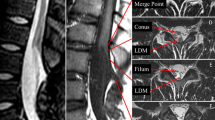Abstract
Limited dorsal myeloschisis (LDM) is characterized by a fibroneural tethering stalk linking the skin lesion to the underlying spinal cord. LDM without an extradural stalk is rare. A full-term boy was noted at birth to have a dimple in the upper back (dorsal skin of the lower thoracic region). Computed tomographic scan showed spina bifida at the T9–12 vertebral level and osteochondral tissue at the T10 level. Magnetic resonance imaging (MRI) demonstrated a tiny dorsal lipoma at the T8 vertebral level, but the intradural tethering tract was not apparent. At 18 days of age, the congenital dermal sinus (CDS) tract started from the dimple and terminated at the osteochondral tissue, without continuity of the dura mater, and the osteochondral tissues were resected. At age 2 years 8 months, he developed spastic paresis of the right foot. On MRI, the tethering tract from the dorsal lipoma became apparent. During the second surgery at age 2 years 11 months, the intradural stalk started from the dorsal lipoma and joined the inner surface of the dura mater was untethering from the cord. Postoperatively, right spastic paresis was improved. Histological examination of the intradural stalk revealed the distribution of S100-immunopositive peripheral nerve fibers, which is one of the histopathological hallmarks of LDM. We speculated that the extradural stalk with coexisting CDS originally linked from the skin lesion subsequently regressed and was replaced by fibroadipose tissue with osteochondral tissue migration. Intradural exploration should always be seriously considered in these disorders of persisting neurocutaneous connection.




Similar content being viewed by others
References
Morioka T, Murakami N, Suzuki SO, Takada A, Tajiri S, Shimogawa T, Mukae N, Iihara K (2020) Neurosurgical pathology and management of limited dorsal myeloschisis with congenital dermal sinus in infancy. Pediatr Neurosurg 55(2):113–125
Pang D, Zovickian J, Oviedo A, Moes GS (2010) Limited dorsal myeloschisis: a distinctive clinicopathological entity. Neurosurgery 67:1555–1580
Pang D, Zovickian J, Wong S-T, Hou YJ, Moes GS (2013) Limited dorsal myeloschisis: a not-so-rare form of primary neurulation defect. Childs Nerv Syst 29:1459–1484
Tomita Y, Morioka T, Murakami N, Noguchi Y, Sato Y, Suzuki SO (2019) Slender stalk with combined features of saccular limited dorsal myeloschisis and congenital dermal sinus in a neonate. Pediatr Neurosurg 54:125–131
Wong ST, Kan A, Pang D (2020) Limited dorsal spinal non-disjunctional disorders: limited dorsal myeloschisis, congenital spinal dermal sinus tract, and mixed lesions. In: Di Rocco C, Pang D, Rutka JT (eds) Textbook of Pediatric Neurosurgery, 1st edn. Springer, Switzerland, pp 1–64
Murakami N, Morioka T, Suzuki SO, Mukae N, Shimogawa T, Matsuo Y, Sasaguri T, Mizoguchi M (2020) Clinicopathology findings of limited dorsal myeloschisis associated with spinal lipoma of dorsal-type. Interdiscip Neurosurg 21:100781
Eibach S, Moes G, Zovickian J, Pang D (2017) Limited dorsal myeloschisis associated with dermoid elements. Childs Nerv Syst 33(1):55–67
Lee JY, Park S-H, Chong S, Phi JH, Kim S-K, Cho B-K, Wang K-C (2019) Congenital dermal sinus and limited dorsal myeloschisis: “spectrum disorders” of incomplete dysjunction between cutaneous and neural ectoderms. Neurosurgery 84:428–434
Lee JY, Chong S, Choi YH, Phi JH, Cheon J-E, Kim S-K, Park SH, Kim I-O, Wang K-C (2017) Modification of surgical procedure for “probable” limited dorsal myeloschisis. J Neurosurg Pediatr 19:616–619
Morioka T, Suzuki SO, Murakami N, Shimogawa T, Mukae N, Inoha S, Sasaguri T, Iihara K (2018) Neurosurgical pathology of limited dorsal myeloschisis. Childs Nerv Syst 34:293–303
Morioka T, Suzuki SO, Murakami N, Mukae N, Shimogawa T, Haruyama H, Iihara K (2019) Surgical histopathology of limited dorsal myeloschisis with flat skin lesion. Childs Nerv Syst 35:119–128
Sarukawa M, Morioka T, Murakami N, Shimogawa T, Mukae N, Kuga N, Suzuki SO, Iihara K (2019) Human tail-like cutaneous appendage with a contiguous stalk of limited dorsal myeloschisis. Childs Nerv Syst 35:973–978
Morioka T, Murakami N, Ichiyama M, Kusuda T, Suzuki SO (2020) Congenital dermal sinus elements in each tethering stalk of coexisting thoracic limited dorsal myeloschisis and retained medullary cord. Pediatr Neurosurg 55(6):380–387
Morioka T, Murakami N, Shimogawa T, Mukae N, Hashiguchi K, Suzuki SO, Iihara K (2018) Neurosurgical management and pathology of the lumbosacral lipomas with tethered cord. Neuropathology 37:385–392
Shimogawa T, Morioka T, Murakami N, Mukae N, Hashiguchi K, Suzuki SO, Iihara K (2018) Bony and cartilaginous tissues in lumbosacral lipomas. Pediatr Neurosurg 53:305–331
Hiraoka A, Morioka T, Murakami N, Suzuki SO, Mizoguchi M (2018) Limited dorsal myeloschisis with no extradural stalk linking to a flat skin lesion. Childs Nerv Syst 34(12):2497–2501
Tisdall MMMM, Hayward RDRD, Thompson DNP (2015) Congenital spinal dermal tract: how accurate is clinical and radiological evaluation? J Neurosurg Pediatr 15:651–656
Author information
Authors and Affiliations
Corresponding author
Ethics declarations
Ethics approval
Approval was obtained from the ethics committee of Takatsuki General Hospital. The procedures used in this study adhere to the tenets of the Declaration of Helsinki.
Consent to participate
Informed consent was obtained from the parents. The participant has consented to the submission of the case report to the journal.
Conflict of interest
The authors have no conflicts of interest to declare that are relevant to the content of this article.
Additional information
Publisher's Note
Springer Nature remains neutral with regard to jurisdictional claims in published maps and institutional affiliations.
Rights and permissions
Springer Nature or its licensor holds exclusive rights to this article under a publishing agreement with the author(s) or other rightsholder(s); author self-archiving of the accepted manuscript version of this article is solely governed by the terms of such publishing agreement and applicable law.
About this article
Cite this article
Kawamoto, Y., Harada, A., Ikura, Y. et al. Limited dorsal myeloschisis without extradural stalk continuity to coexisting congenital dermal sinus. Childs Nerv Syst 39, 511–515 (2023). https://doi.org/10.1007/s00381-022-05631-3
Received:
Accepted:
Published:
Issue Date:
DOI: https://doi.org/10.1007/s00381-022-05631-3




